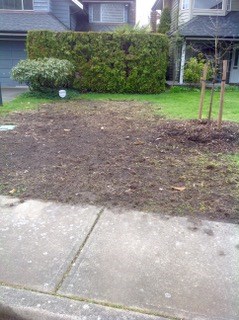All through Richmond, lawns have become a battle ground between homeowners and the chafer beetle. The chafer beetle lays its eggs in poorly managed grass in the summer. Right now the larvae are making their way to the surface of lawn to the delight of crows, skunks and raccoons who tear up our lawns to get at this tasty treat!
We continually hear discussions from homeowners who are considering installing artificial grass. Environmentalists are warning that this growing trend of laying artificial lawns instead of real grass threatens wildlife and habitat in our urban area.
Artificial lawn is made from a mix of plastics - polypropylene, polyurethane and polyethylene. Think about this. It takes fossil fuels to make it, so there is a carbon impact to the environment. You have to remove a significant amount of soil to lay it, so you are reducing the direct and indirect porosity of the soil. You are removing habitat which a wide range of species are dependent upon. And the worst part of artificial lawn is that at the end of its life, it has to go back into landfill.
In the City of Vancouver, there is a bylaw that does not allow private homeowners to install artificial lawn. Of course, the enforcement of the bylaw relies on neighbours complaining to the city.
Instead of creating bylaws, it is time for us to choose mindful gardening practices when making changes to our landscapes. We live in a very busy world, so making choices to make our lives easier can be detrimental to our earth. Removing habit from our pollinators and wildlife can directly affect our food sources and our healthy air.
Other solutions to improving our love of green lawns is to choose grass seed blends that the chafer beetle does not like. Grass seed that contains a mix of clover and a fescue that establish deep roots is not an appealing environment for the chafer beetle. Most of these ground cover solutions are also drought resistant, require less mowing and stay greener through hot, dry weather in our changing summers.
These solutions make our lives much easier, much greener (less mowing) and give back to the environment by providing more oxygen, more habitat for our pollinators and keep us cool in the summer! Contact your local landscape company for assistance on replacing your chafer beetle battle-ground with an environmentally friendly alternative.
Lynda Pasacreta is the current president of the Richmond Garden Club. For more information, visit richmondgardenclub.ca.



